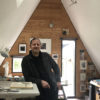Based near Glasgow, Scotland, artist Lola Dupré works on art projects and commercial commissions with her trademark and unique style. In 2014 we asked Lola our “7 questions to…” standard interview that we had at that time. Now, seven years later, we wanted to catch up with her and get to know more about her art and ideas.
TWS –Can you remember your first encounters with art? Was it something you were interested in as a child or was it present in your family? Did it come later on in your life?
LD –I was lucky when I was a little kid my family had great art prints around the house, I always remember Dulle Griet from Bruegel was pinned to the wall beside the toilet in the bathroom. It was really fascinating to me, mysterious, beautiful, so full of secret wonderful details. It was art but not boring at all, like a great graphic novel all crushed down into one page. Also I remember Dali, Kallmus, Dorothea Tanning, Picasso, Warhol in other rooms.. Then when I was in primary school I had a great art teacher, I cant remember his name, but he basically just encouraged you to do whatever you wanted and it was my favourite part of school life. By the time I was maybe about 8 years old I must have been already very interested in art. I think I used to make paintings with mud and anything I could find, it was fun.
TWS – And how and where you started working will collage? Can you recall your first experiences with this medium?
LD – Yes, I picked up some free magazines in Switzerland years ago. Multiple copies of the same issue, I suppose it was kind of a revelation to piece the pages together. It made me think about the Slave To The Rhythm, Grace Jones Jean-Paul Goude cover art.
Before that, when I was a toddler, I had some toys called ‘fuzzy felt’, it was like a collage with pieces of sticky fabric you could arrange in funny ways.

TWS –Your approach to collage is unique in many ways. It seems like a personal (and enhanced) reinterpretation of some of Jirí Kolár’s techniques plus the mindset of the surrealists -among other influences.
How would you describe your approach to collage and art? And which are the influences that you feel had helped you shape more clearly your work?
LD –Thank you, of course I always loved Kolár’s work. Also I was inspired a lot by Jean-Paul Goude and David Hockney. I was always drawn to strange imagery, surreal juxtapositions. I found collage to be the perfect medium for this. Easier and more accessible than paint, and somehow more shocking. I used to combine more images together, now mainly I mash one image up into a new arrangement. I delight in the little details, trying to find the same tone in two areas of a picture so you can seamlessly mix them together.
I try to approach art with an open mind, I try to approach everything with an open mind. Everyone can teach you something. What was right yesterday might not be right today. If a broken clock is right twice a day then keep your mind open to every possibility.
TWS –Your work deals with the idea of distorting reality, transforming the familiar into something new, weird and mysterious. Can you tell us something about the ideas behind this manipulation of reality?
LD– I am really interested in the limits of beauty, even the definition of beauty. I think there is something to be said for symmetry but beauty and attraction blur this definition. Reality is a mysterious thing, between time and light and quantum entanglement it is easy to look at something and see it as if reflected in a warped mirror. Right now I am working on a portrait, the face covered with eyes. I see each eye with a different emotion, and together they float on the liquid skin of the portrait like boats on the sea. I think reality is in the eye of the beholder.

TWS –Another feature of your work is the idea of repetition. What does repetition means to you and your work?
LD –I think its a very clinical binary thing. 1’s and 0’s. Two eyes, one nose, two legs, two more legs!. Easy to follow a pattern and elaborate on repetition. I think through repetition we play with time, we fill any space and like keys on a piano every one makes perfect sense.
TWS –You work always with paper. Why not working on digital? what does the real paper allows you to express that can’t be expressed with a computer?
LD –I would like to experiment with digital in the future. For the moment paper is simply what I am used to. I do appreciate the physical objects created with paper, and I have always in the past worked with exhibiting in physical locations and selling the physical pieces. This is how it began for me, but things change. Paper or digital makes no difference to me when I look at a visual. Most of my inspiration is digital. Recently I sold my first works as NFTs on Hic et nunc and Ghostmarket, and soon perhaps on Algorand. I chose these places are they are currently greener and more affordable options. I think NFTs are a serious long term development, I am chronicling my journey here.

TWS –Your process seems very detailed and time consuming. Are you patient? What do you do while you’re creating this complex pieces? What’s your state of mind while you’re working?
LD –I am patient, dedicated and methodical. I like to be busy and occupied. I do not think of my collage as work, it is a pleasure. My state of mind changes between pieces, sometimes I must concentrate so I listen to music. Sometimes I listen to podcasts, recently Lex Fridman and Sam Harris. I love to listen and learn about the sciences. I am always trying to learn new things. Our time is so short, the possibilities so vast but so constrained. Time is everything.
While I work I drink hot water and I make plans and ideas.

TWS – Why did you agree to make a text interview and not audio one for the TWS podcast?
LD –I like to maintain my privacy. I do not publish images of myself or do any audio recordings.
I have always done things this way. Some times I have lost good projects because of it, but it is how I am happy to exist with my art.
– TWS –Finally: can you share with us your own and personal definition of collage?
LD –Pieces put together. Any two things put together, or one thing broken into two or more pieces and reconstructed. Collage is something constructed.
–
Find more about Lola Dupré’s work on her website or Instagram
–
















